 |
 |
| Home | Welcome | What's New | Site Map | Glossary | Weather Doctor Amazon Store | Book Store | Accolades | Email Us |
 | |||||||||||||||||||||
Weather Almanac for July 1999DID THOSE MOUNTAINS
|
|||||||||||||||||||||
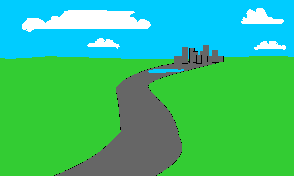 |
across roadway. |
Yes, mention the word mirage and many of us, particularly those of us who represent the older generations, will picture a desert oasis shimmering on the horizon with a water body and a palm tree, a desert mirage. And yet, if I phrased it slightly differently -- "Picture traveling down a highway on a sunny day and look out ahead of you, what do you see across the pavement?" -- most recall the scene having a pool of "water" across the highway in the distance. This pool, however, can never be reached; it always disappears as you approach. If you have seen this vision, then you have seen a mirage, one today we commonly call a highway mirage.
Both the highway mirage and the desert mirage represent a common form of mirages known technically as inferior mirages, most often seen over a land surface. The other main form of mirage is the superior mirage, most often viewed around or over large bodies of water or snow/ice fields. (For links to more detailed technical descriptions of mirages, see the list of articles at the end of this piece.)
A mirage is defined by my standard English dictionary as "an optical illusion due to atmospheric conditions by which reflected images of distant objects are seen." I'll excuse the lexicographers on the use of the word reflected because it seems more appropriate even if incorrect. Actually they were only two letters off, the proper technical term should be refracted.
We consider mirages as illusions because of the air of magic surrounding their appearance and behaviour. Indeed, many folk stories, legends and fairy tales have focused on mirages caused by devils or impish fairies to trick unsuspecting humans. A particularly common storyline has thirsty travelers trudging in vain toward the "pool of water" lying just ahead, but they never are able to reach it.
One form of superior mirage is actually so common that even most scientists do not recognize it as a mirage. Have you ever seen the sun lying right on the horizon? And what was the actual position of the sun at that time? Yes, this is a trick question.
The fact is, when you see the full solar disk directly on the horizon, all or part of it is below the horizon, but the bending (refracting) of the solar rays by the atmosphere gives us the optical illusion that the sun is actually on the horizon. This happens at both sunrise and sunset each day and adds over 4 extra minutes of daylight to each day. As a result, daylight is a little longer than the night period on the date of the Equinox by about 4 minutes. [see Equal Night and Day?]
Mirages form when light passing through the atmosphere is refracted by the differences in density of the air. The index of refraction (a measure of the degree of bending of the light by the medium) for air is directly proportional to the air density. Air density is proportional to its pressure (density increases as pressure increases), and inversely proportional to its temperature (density decreases as temperature increases).
The effect on the setting/rising sun's position discussed above is mostly due to the increase in density due to atmospheric pressure increases as the solar rays come from outer space toward the Earth's surface. But in the lowest atmospheric layers, density differences are more dependent on the temperature changes than the pressure changes. Therefore when there is a strong variation of temperature over a short height (known as the temperature gradient) in the lower atmosphere, the path of light rays can be bent significantly from a straight line path. The bend is always toward the direction of the higher density (and therefore lower temperature). Some very interesting optical effects can occur when the atmosphere has multiple layers of differing density, such as the appearance of boats floating upside down in mid-air. (In the diagrams accompanying this article, the dark lines indicate the actual light ray path and the white dashed lines the path our mind thinks it sees.)
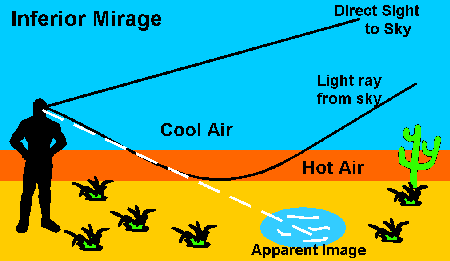 |
Simply stated, when there is very warm air underlying relatively cooler air, you should look for inferior mirages, so called not because of the quality of the image but because the image we see is below the actual position of the object. In contrast, when the air at the surface is very cold relative to that above it, you may see a superior mirage. Here superior indicates the image we see is above the actual image position.
The illusional part of a mirage comes in the way our mind processes what our eyes see. When we view the light rays from an object, our mind makes the usually correct assumption that a straight line from our eyes connects directly to the location of the object or any detail on it. It has no way to correct for any possible bending of the light. (Although through reasoning, we can mentally make this correction after the fact.) Thus, when we see a "pool of water" on the ground, we expect that pool to actually be on the ground.
When we view an inferior mirage "water pool" on a road or desert or other hot surface, what we are actually seeing is the image of the bluish sky being strongly refracted by the air near the surface so that it appears to our mind to be water lying on the surface. The appearance of the inferior mirage indicates that the surface air is much warmer than the air above it due to the strong heating of the surface by the sun. This temperature structure -- very hot below and cool above -- causes light rays passing through it to be bent upward.
The superior mirage occurs under reverse atmospheric conditions from the inferior mirage. For it, the air close to the surface must be much colder than the air above it. This condition is common over snow, ice and cold water surfaces. When very cold air lies below warm air, light rays are bent downward toward the surface, thus tricking our eyes into thinking an object is located higher or is taller than it actually is.
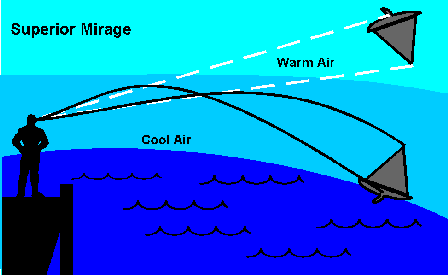 |
The superior mirage can make objects appear to be floating in the air or cause objects actually located below the horizon to appear above it (remember the setting-sun example), a condition called looming. The superior mirage can also make objects appear to be taller than they actually are, a condition called towering. The image often appears inverted as well.
The weather conditions that form superior mirages are quite common at night when radiational cooling of the air near the surface, under clear skies and light winds, is strong. Mirages at this time are seldom noticed, however, since it is usually dark. But artificial lighting, particularly from buildings and vehicle headlights, can be lofted from their expected position.
The superior mirage could be the source for some UFO sightings. Here's why. The light from headlights on automobiles moving up a sloped road can be refracted under proper atmospheric conditions so that they appear to come from the heavens rather than from the road surface and can then move quickly across the sky or can disappear suddenly as the vertical angle of the light beam on the moving vehicle changes.
Both inferior and superior mirages are common sights here in Victoria, British Columbia. A few days ago, I had the opportunity to see both simultaneously! I was driving south toward the City Centre and the Strait of Juan de Fuca, across which rise the snow-capped peaks of the Olympic Mountains. On the road ahead of me this sunny afternoon were a series of run-of-the-mill highway mirages. But as I looked upward toward the horizon, I saw the snow-capped summits of the higher Olympics peaks across the waters in Washington State looming so high above me that they appeared to be located just the other side of town.
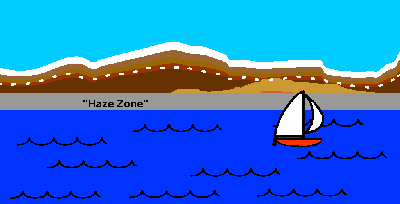 |
There are days here when, if you sit in one spot, you can watch the snow-capped summits rise from their morning height to a peak in late afternoon and then subside again as the evening draws on to a close. This looming of the mountains occurs because the air near the surface, in contact with the cold ocean water of the strait, remains cold all day while the air in higher layers warms under the sun.
You can also see the apparent heights of the peaks change as you move around the metropolitan region and view them from different elevations. In these cases, the light rays may move through layers of differing density between the peaks and your viewing locations, and they are bent differently depending on the properties of the layers. This makes them appear taller here and lower there, and you really have trouble determining what the actual height should be.
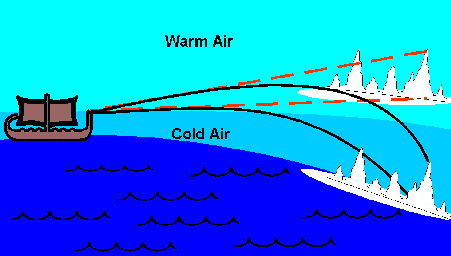 |
The superior mirage is as common in the polar regions as the inferior mirage is in the tropics and subtropics. In fact, if we look closely we can often see the influence of the superior mirage on the religions and legends of native northern communities. And there is ample evidence that Viking and other European polar explorers may have discovered new lands because they saw mountains looming above the western horizon, although in most instances they were really only seeing pack ice or small icebergs altered by mirage conditions appearing as mountains. Historians believe that the voyages of Erik the Red to Greenland and his son Lief Erikson to North American shores were made possible because they believed they had seen great lands and mountains to the west, visions made possible by persistent and strong superior mirages.
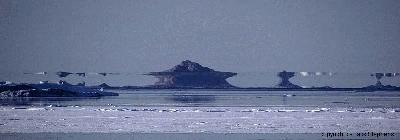 |
©1999, Jack Stephens Images, All Rights Reserved. Used with permission. |
Mirages can also have a playful side -- inverting images of ships at sea and hanging them in mid-air or constructing dancing fairy castles over the waters, the Fata Morgana. There are even recorded instances when the polar night was broken several days prior to the expected polar dawn. This effect, called the Novaya Zemlya, after the Arctic island of the same name, was first reported in 1596 when an ice-bound expedition searching for the Northeast Passage to the Orient surprisingly watched the sun rise two weeks earlier than expected and then set again!
If you look closely, you may find one or more of the variations of the superior or inferior mirages in your area. Often the effect is subtle and hard to distinguish from normal conditions. And look for other effects of the inferior mirage and you may see more than imaginary pools of water. The inferior mirage can be seen in urban areas or on paved roads almost any sunny day of the year.
Both types of mirage are more common than you imagine. Therefore, I was surprised in researching this piece that neither the Peterson nor National Audubon Society Field Guides to weather and the atmosphere had even a paragraph on either mirage (or else they hid them well). The National Audubon Society's First Field Guide: Weather does devote two pages to mirages.
For details on mirages, their causes and properties, see
Mirages in the Weather Phenomenon and Elements Section,
The Inferior Mirage: Not Just For Deserts Anymore in the Weather Elements and Phenomena Section,
The Superior Mirage: Seeing Beyond in the Weather Elements and Phenomena Section,
and
The Arctic Mirage in the Weather People and History Section.
 |
To Purchase Notecard, |
Now Available! Order Today! | |
 |
 |
NEW! Now |
The BC Weather Book: |


